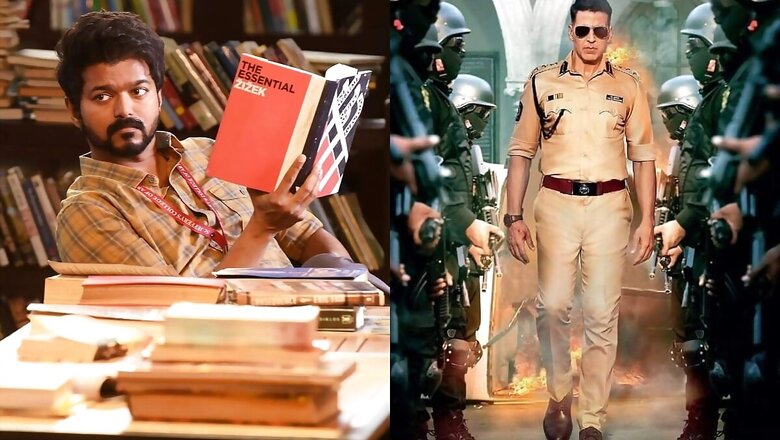
views
Amidst the COVID-19 pandemic, the massive box office earnings of Tamil thriller Master and Telugu actioner Krack down south have proved that despite multiple streaming offerings at home, the magic of the big screen isn’t going to vanish and the culture of cinema-going will, in fact, flourish even further.
“After Master and Krack, there’s no more uncertainty around whether people will come to the theatres,” says film exhibitor Akshaye Rathi. “Their willingness to come is more now but the only thing that we need to provide them is content compelling enough to bring them to the theatres,” he adds.
At a time when the exhibition sector is struggling to survive after theaters across the country were forced to shut their doors in the wake of the coronavirus pandemic, the commercial success of Master and Krack is truly a blessing. Despite some theatres shuttered and capacity reduced to 50 per cent, Master, starring Thalapathy Vijay, smashed box office records, pulling in an astonishing Rs 158 crore globally in its opening weekend. While Krack, which arrived in cinemas on January 9, became the highest-grossing film of Ravi Teja’s career with gross collection standing around Rs 60.60 crore.
However, their earth-shattering box office records in the COVID-19 era pose a genuine question as to what’s stopping India’s another leading film industry, popularly known as Bollywood, to release their long-held potential blockbusters like Sooryavanshi and ’83? The question is inevitable now that the centre has also allowed 100 percent occupancy in multiplexes and cinema halls.
“The economics of south films are very different from the Hindi films. South movies predominantly generate revenues from four states including Tamil Nadu, Telangana, Karnataka, and Kerala so the majority of their theatrical revenues come from limited states down south. Whereas for the Hindi films which have larger budgets, the makers have to ensure that the revenue pie they are seeking should be larger,” film producer and trade analyst Girish Johar points out, before adding that the most state governments are yet to give their approval for the 100 per cent occupancy in the theatres.
Cinema is state government’s subject
“Delhi, Maharashtra and Uttar Pradesh are the largest domestic markets for the Hindi films and we have not yet got the 100 per cent occupancy clearance from any of these states,” says trade analyst Atul Mohan. “In fact, even after 11 months, the Rajasthan government allowed the opening of cinema halls with up to 50 per cent seating capacity only. Till we don’t get the full occupancy in the theatres, filmmakers wouldn’t want to risk their product and investment in these times.”
International film markets are sitting at a critical juncture
In recent years, Bollywood films have chased money from other countries like Canada, the UK and the US. But majority of theatres are shut in these countries. So, it isn’t just the domestic box office that is in jeopardy for the Hindi films, their revenue potential from the overseas also seems questionable right now.
“The Covid scenario in these major international markets is worse. The makers are hoping that certain state governments will allow the 100% occupancy in the theatres soon so that they can think of excluding the overseas business to a certain extend. But they first need to be sure that they are being compensated enough in India to be able to take that risk,” says Johar.
Producers versus film exhibitors
There have also been reports doing the rounds that the makers of Akshay Kumar-starrer Sooryavanshi have asked for 70% revenue share from the film exhibitors. For the unversed, movie theatres usually get to keep about fifty percent of gross revenues. For the longest time, film producers didn’t have a choice to release their films on any other platform except cinema halls but the emergence of OTT has disrupted the cinema business drastically and has also given the film makers an upper hand over exhibitors when it comes to negotiations.
“Even though we have not yet been offered any such terms by any distributor, it wouldn’t be too shocking if this turns out to be true, owing to the unprecedented times,” says Raj Kumar Mehrotra, General Manager- Delite Cinemas. “This usually happens when the release date of a film is officially finalised but it could be possible that since it’s a very big film, the makers might want to see the positioning of their product in the market and what they can get in the first round of negotiation. Also, now they have an option to release their films on OTT platforms and they are getting good offers for the same, so I’m sensing that we might face a little difficulty on that front.”
“These small issues keep happening but the film industry is like a family where people come together, sit and discuss the problems,” says Rajasthan-based film exhibitor Raj Bansal, who adds that there’s a minor argument going on between the makers and the theatre owners regarding the film’s OTT premiere.
“It’s currently being debated that exactly after how many days post the theatrical release, the film should stream on an OTT platform. But we will soon come to an agreement. It’s just a matter of who breaks the ice,” he says.
Eyeing festive release
Over the years, Bollywood’s biggest superstars including Salman Khan, Shah Rukh Khan, Aamir Khan and Akshay Kumar have had a hold over the holiday seasons in order to get maximum footfall and undivided attention of the audience. So, it won’t be surprising if Sooryavanshi arrives in the cinemas around Holi, which is on March 29.
“Big films usually release around a festival and now that the Republic Day has also gone, they are eyeing for Holi 2021 release. Before that I don’t see any big Hindi movie releasing in the theatres,” says Bansal.
Read all the Latest News, Breaking News and Coronavirus News here



















Comments
0 comment